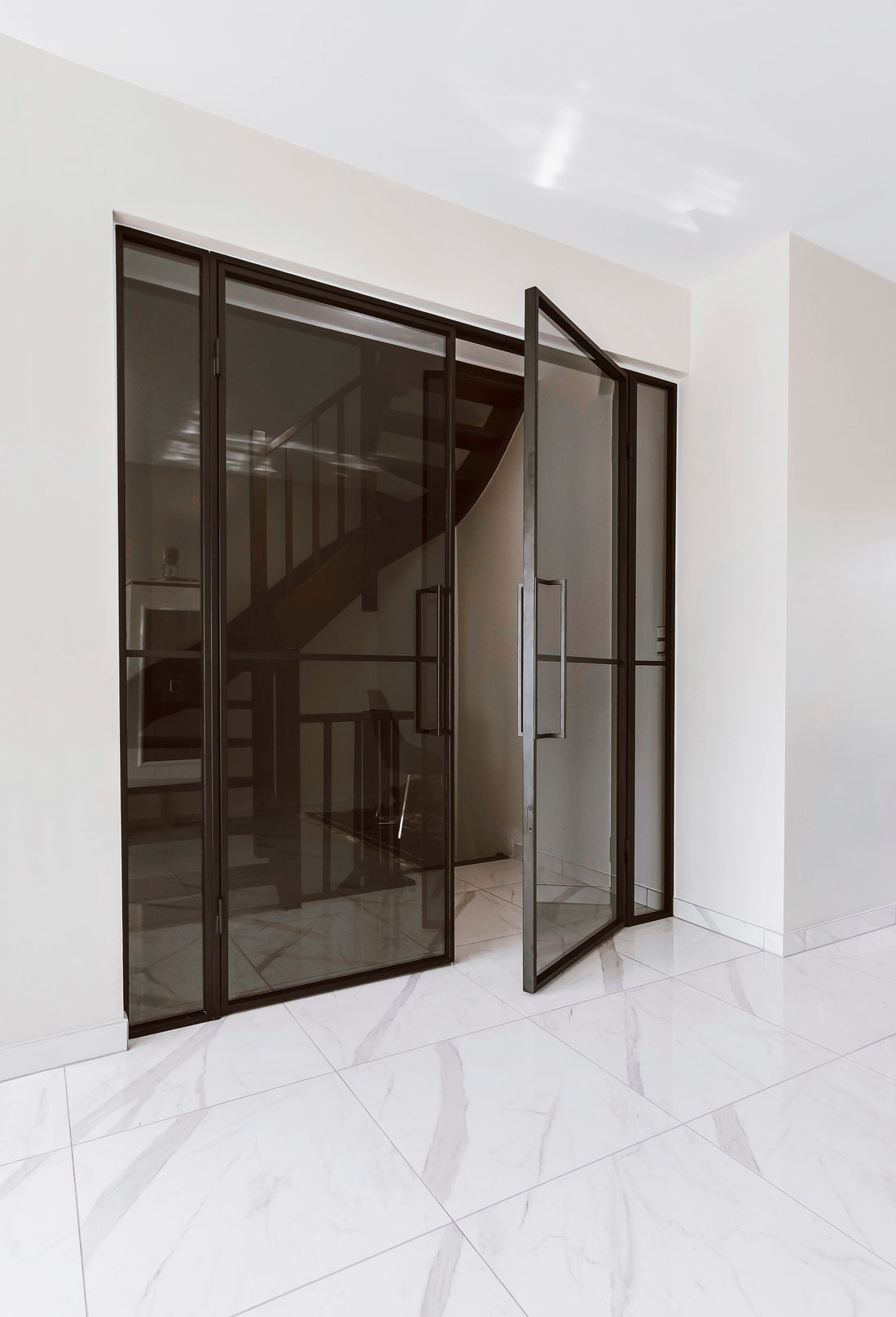
Best Steel Doors for Commercial Properties
Samuel MorrisBest Steel Doors for Schools, Hospitals, and Public Buildings | Quick Guide
Public buildings are some of the most demanding environments for building materials. From the constant foot traffic in school corridors to the strict hygiene requirements in hospitals, everything must be built to last, perform reliably, and comply with detailed safety regulations. Among the most critical yet often overlooked features of these buildings are the doors themselves.
View OTIF Steel Doors for Designs and Prices

When longevity, fire resistance, hygiene, and security are all top priorities, steel doors consistently outperform timber and composite alternatives. In this guide, we explore why steel doors are the ideal choice for schools, hospitals, and public buildings, and what options are best suited for different applications.
Why Steel Doors Are the Ideal Solution
Steel doors are renowned for their durability and versatility. Unlike traditional timber doors, which can warp, swell, or degrade over time, steel doors maintain their form and function for decades—even in high-traffic or high-moisture environments. This long-term reliability is one of the reasons they are so widely specified in public buildings.

View OTIF's Double Door Options
Steel doors are also inherently more resistant to impact. In a school setting, for example, classroom and corridor doors endure frequent slamming, accidental kicks, and the wear and tear of backpacks and trolleys. A timber door might show signs of damage within months, while a powder-coated steel door will look and function like new for years.
Beyond resilience, steel doors can also be configured to meet specific safety and compliance requirements. Whether it’s fire-rated doors with vision panels for school corridors or anti-ligature, hygienic doors for hospital wards, the design possibilities are far more flexible than many realise.
Fire Safety and Building Regulations
One of the most important reasons to choose steel doors in public buildings is their ability to meet or exceed fire safety standards. Steel doors can be certified to FD30, FD60, or even higher fire ratings. This means they can withstand fire for 30 or 60 minutes, giving occupants time to evacuate and emergency personnel time to respond.

In addition to fire resistance, these doors are also engineered to meet the strict requirements of the UK’s building regulations. In hospitals, for instance, fire doors often need to be combined with hygienic finishes and smoke seals, while in schools, fire doors must sometimes allow for visibility and supervision via fire-rated glass vision panels.
Because steel is non-combustible and highly stable, it’s the preferred material for ensuring consistent fire performance over the long term—something timber and composite doors can’t always guarantee.
Enhanced Security and Access Control
Security is a major concern in public buildings. In schools, this might involve restricting access to staff-only areas or locking away valuable equipment. In hospitals, it's about controlling entry to pharmacy stores, labs, or medical supply rooms. Steel doors offer the kind of robust security that's often needed in these situations.

Steel doors can be outfitted with high-security locks, access control systems, and reinforced frames to deter forced entry. Whether you need card readers, electronic keypads, or remote locking systems, steel doors can seamlessly integrate with modern security infrastructure. The strength of steel makes it more resistant to tampering or attack, offering peace of mind in environments where safety and access control are paramount.
Hygiene and Cleanliness in Healthcare Settings
In hospitals and healthcare facilities, cleanliness is more than just important—it’s essential. Doors in these environments must be easy to sanitise, resistant to bacterial growth, and able to withstand frequent cleaning with strong chemicals.

Steel doors are available with anti-bacterial powder coatings and smooth, non-porous surfaces that do not absorb moisture or germs. This makes them ideal for use in patient wards, operating theatres, and treatment rooms. Unlike wood, which can be difficult to disinfect thoroughly, steel provides a consistent, wipe-clean surface that maintains its integrity over time.
Additionally, in settings like surgical theatres or isolation rooms, sealed-edge steel doors can prevent the ingress or spread of airborne contaminants, further protecting patients and staff.
Low Maintenance, Long-Term Value
One of the often-overlooked benefits of steel doors is their minimal maintenance requirements. While timber doors might require regular sanding, repainting, or even full replacement due to warping, steel doors typically only need occasional cleaning and minor adjustments.

In public buildings where budgets are under pressure and facility managers are stretched thin, the long-term value of steel is undeniable. These doors are designed to last 20 years or more with virtually no need for repairs. This results in substantial cost savings over time—not only in materials but also in labour and downtime.
For schools, hospitals, or government buildings, choosing steel means fewer headaches, fewer service calls, and more predictable long-term performance.
Tailored Options for Every Application
Not all steel doors are the same. In fact, modern manufacturing allows for customisation to suit a wide range of environments. For example, in schools, it’s common to install fire-rated steel doors with vision panels in corridors and classrooms. These panels improve safety by allowing teachers and staff to see through doors without compromising fire resistance.

In plant rooms or utility areas, solid steel doors with louvre panels may be used to allow ventilation while still providing fire protection and security. For toilets and locker rooms, corrosion-resistant coatings and DDA-compliant hardware are often specified to ensure accessibility and durability.
Hospitals demand even more tailored solutions. Doors in operating rooms may include acoustic linings or lead-lined cores for x-ray protection. Wards and patient rooms benefit from doors with quiet-close hinges and flush glazing to reduce disruption and promote a calm environment.
Even external doors for council buildings or libraries can be finished with wood-effect powder coatings or custom colours to complement architectural aesthetics while retaining all the benefits of steel.
Design, Aesthetics, and Flexibility
Historically, steel doors were seen as industrial and unattractive. That’s no longer the case. Today’s steel doors can be stylish, minimal, and seamlessly integrated into modern interiors. Whether it’s a sleek black-framed glazed door in a school reception area or a clean white antibacterial door in a hospital corridor, steel can look as good as it performs.

Powder coating allows steel doors to be finished in any RAL colour, from institutional greys and blues to bright, welcoming tones suited for educational environments. For spaces where timber aesthetics are still desired, woodgrain finishes can replicate the appearance of oak, walnut, or ash—without sacrificing the performance benefits of steel.
This design flexibility ensures that steel doors are no longer limited to service areas or fire escapes—they are now a stylish, front-of-house option for any public building.
Choosing the Right Supplier and Installation Team
Of course, even the best steel door is only as effective as its installation. To maintain fire ratings, ensure airtight seals, and guarantee proper operation, installation must be carried out by experienced professionals.
When choosing a supplier, look for one that offers:
- Fully certified fire-rated doors tested to UK and European standards
- Doors tailored for education, healthcare, and civic use
- Bespoke sizes, finishes, and hardware options
- Project management support from quote through to delivery and fitting
At Interior Doors Ltd, we work closely with architects, contractors, and facilities managers to provide high-performance steel door systems for every type of public building. We ensure each door is tailored to its environment—whether that’s a busy school corridor, a hospital lab, or a community centre entrance.

Conclusion: The Smarter, Safer Choice
Steel doors have become the standard for public buildings for good reason. Their strength, reliability, and adaptability make them the ideal choice in places where performance, safety, and durability can never be compromised.
For schools, hospitals, and public facilities looking to invest in safer, longer-lasting infrastructure, steel doors provide the ultimate combination of form and function. They meet today’s regulations, handle tomorrow’s wear and tear, and offer a cleaner, more secure solution for everyone who walks through them.
